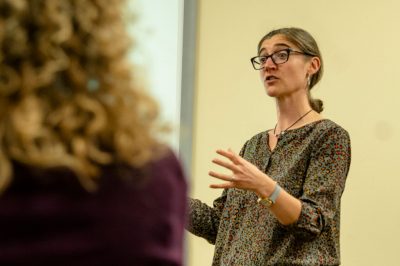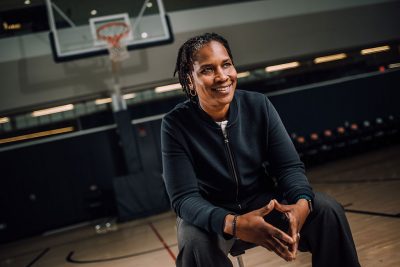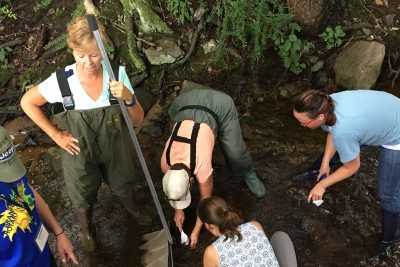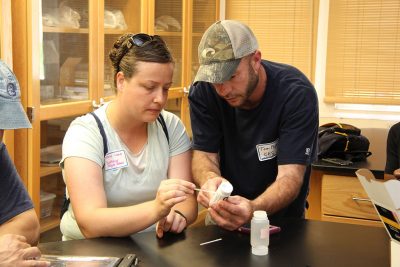CT Mirror (Neag School alum and assistant superintendent of Meriden Public Schools, Miguel Cardona, is expected to be chosen as Connecticut’s next education commissioner)
IES Awards $6.9M for Neag School Research

The following piece was originally published in UConn Today.
The Institute of Education Sciences (IES) announced last week that researchers from the University of Connecticut’s Neag School of Education have been awarded $6,896,988 over five years for three research projects related to special education. A faculty member from the Neag School of Education is also serving as co-prinicpal investigator on a $3,999,320 project awarded to the University of Kansas.
“Given that the Neag School’s mission is to improve educational and social systems to be more effective, equitable, and just for all,” says Neag School Dean Gladis Kersaint, “federal funding for research focused on key issues in special education aligns seamlessly with our efforts to support educators, policymakers, and students nationwide. We are delighted that these exceptional faculty scholars and their research teams are able to continue advancing important educational research in this realm.”
As the research arm of the U.S. Department of Education, IES provides scientific evidence to guide education policy and practice. The organization also shares this information for use by educators, law and policymakers, researchers, the public, and parents. IES administers several highly competitive funding mechanisms, such as those discussed here.
“We are delighted that these exceptional faculty scholars and their research teams are able to continue advancing important educational research in this realm.”
— Dean Gladis Kersaint
Improving Reading and Behavior Outcomes
Two of the UConn Neag School projects that received funding are part of the Multi-Tiered Systems of Support (MTSS) Network. MTSS is the first research network funded through through one of IES’ four research centers, the National Center for Special Education Research (NCSER). The Neag School’s team has been selected to lead this new national initiative.
According to a release from IES, Research Networks like MTSS “focus resources and attention on high-priority issues, creating a structure and process for researchers to advance the field’s understanding beyond what an individual research team is able to do on its own” to strengthen education policies and programs for children with disabilities.
With more than $17 million invested by NCSER in five coordinated projects, the MTSS Network will evaluate educational frameworks with multiple levels of integrated behavioral and academic support for elementary school students. Research projects funded through the MTSS Network will pay particular focus to outcomes for students experiencing or at risk for disabilities.
Professor of educational psychology, Michael Coyne, will serve as principal investigator for one of the Network’s research projects entitled “Evaluating the Impact of Integrated Behavior and Reading Multi-Tiered Systems of Support in Elementary Schools.” Brandi Simonsen and D. Betsy McCoach, both professors in the Department of Educational Psychology, will serve as co-principal investigators. Professors Jennifer Freeman and Devin Kearns, also from Educational Psychology, will serve as co-investigators. The NCSER award will provide $3,999,589 to the UConn research team over five years.
As part of this project, researchers from UConn’s Neag School of Education will evaluate how integrated behavior and reading practices impact outcomes for K-Grade 2 students at 25 schools. Previously conducted research has shown certain reading and behavior practices to be effective for students with learning disabilities or those who are at risk for developing them. This project aims to examine how resources could be employed more efficiently to address the common co-occurrence of reading and behavior difficulties.
At the conclusion of the five-year award period, the UConn research team’s findings are expected to provide educators, policymakers, and fellow researchers with valuable evidence of the impact on integrated behavior and reading practices. This information will help school systems better align resources and support student outcomes.
Fellow Neag School researcher, Sandra Chafouleas, will also collaborate with colleagues from the University of Kansas to test a systems-level framework in a project titled “Enhancing Ci3T: Building Professional Capacity for High Fidelity Implementation to Support Students’ Educational Outcomes (Project ENHANCE).” Chafouleas, a Board of Trustees Distinguished Professor in the Department of Educational Psychology, is a co-principal investigator on the five-year, $3.9 million grant which will fund “the first randomized control trial to both test the system’s efficacy and simultaneously provide tools for sustained implementation in schools,” according to a press release from the University of Kansas, the prime award recipient.
Fostering Collaborative Research Efforts
Researchers from UConn’s Neag School of Education not only received this grant as part of the MTSS Network, but were also awarded funding to lead the Network’s activities. Co-principal investigators Michael Coyne and Brandi Simonsen will be joined by fellow Neag School researcher George Sugai, as well as colleagues from the University of Oregon and Florida State University to lead “Multi-Tiered Systems of Support Research Network (MTSS-RN) Leadership Team.” The NCSER award will provide $1,499,572 to the UConn research team over five years to support the necessary organizational oversight for efficient coordination of the five awarded projects. The MTSS Network Lead’s primary responsibilities include administration and coordination of the network, including in-person meetings, the development of a shared vision for the Network, synthesis and dissemination of the final findings at the conclusion of the award period, and coordination of training to help prepare future MTSS researchers for successful careers in the field.
College and Career Readiness
NCSER also awarded $1,398,298 to Allison Lombardi, associate professor of educational psychology. While Lombardi’s project falls under the topic area focused on Transition Outcomes for Secondary Students with Disabilities rather than the MTSS Network, it nonetheless aims to improve outcomes for students with disabilities. “College and Career Readiness for Transition (CCR4T): Development and Validation of a Student Measure” will provide high school educators in Connecticut, Arkansas, Delaware, Massachusetts, and North Carolina with a validated tool for assessing college and career readiness (CCR) for students with disabilities.
While transitioning from high school to postsecondary courses is hard for many students, those with disabilities face even greater challenges. These challenges underprepare them for college-level classes, make them less likely to pursue higher education, and hinder their chances of attaining jobs that require college degrees. Through the CCR4T tool, students will complete a self-assessment to measure their personal perceptions of their own college readiness. The report will supplement existing school data to evaluate areas of need and to help educators make more informed decisions about offering support.
Joining Lombardi as co-principal investigators are Neag School faculty Hariharan Swaminathan, Jane Rogers, and Jennifer Freeman, as well as collaborators from the Portland State University and University of North Carolina, Charlotte.
IES Award Numbers: R324A190012, R324A180020, R324A190170, and R324N190002.
Sarah Woulfin Named Co-Editor of Educational Researcher

Sarah Woulfin, associate professor in the Neag School’s Department of Educational Leadership, has been named co-editor of Educational Researcher (ER) for 2019 to 2022.
As the American Educational Research Association’s premier journal, ER publishes scholarly articles that are of general significance to the education research community and that come from a wide range of areas of education research and related disciplines. The journal seeks to make major programmatic research and new findings of broad importance widely accessible.
According to Woulfin, the incoming editorial team’s primary goal is to position ER as a hub for the distribution and integration of knowledge about education and educational improvement. In so doing, they aim to extend ER’s already considerable reach (impact factor = 4.0) by highlighting scholarship and ideas that draw upon multiple disciplinary and methodological perspectives. They also aim to solidify the journal’s position as the go-to venue on issues that are timely and relevant to a broad range of educational stakeholders, policymakers, and practitioners across the United States and around the world.
“The editorial team is dedicated to adopting innovations to expand the reach and impact of [Educational Researcher] to the broader public.”
— Associate Professor Sarah Woulfin
“I am particularly excited about opportunities for ER to push the field’s thinking on cutting-edge qualitative methods, big data and analytics in education, and research-practice partnership approaches,” Woulfin says. “The editorial team is dedicated to adopting innovations to expand the reach and impact of ER to the broader public. They envision powerful additions to the journal, such as one-page, open-access briefs that will accompany each new article, and podcasts with authors related to relevant, high-impact topics.”
Woulfin previously served as an associate editor of Educational Administration Quarterly and Elementary School Journal.
Access past issues of ER online.
Related Stories:
New Darien Schools Superintendent Dr. Alan Addley Takes the Helm
Darien Times (Neag School alum Alan Addley is profiled regarding his new superintendent post)
Barbershop: Nike Recalls ‘Racist’ Air Max Shoe
NPR (Joseph Cooper is quoted about the controversy where Nike pulled the special edition sneakers featuring the Betsy Ross flag)
Wendy Lecker: Charter Schools Bypass Racial Imbalance Laws
Stamford Advocate (Robert Cotto, a doctoral student in the Neag School, co-authored this article about charter schools bypassing racial imbalance laws)
Feds Give Green Light to Controversial Contract Between Memphis Charter School and Catholic Diocese
Chalkbeat (Preston Green comments about legal issues around churches operating charter schools)
Research Shows That Charter Schools do Best for Calif.’s Low-income and Minority Students
LA School Report (Preston Green is quoted about the need for tighter regulation of charter schools)
UConn’s Jamelle Elliott: Where She is Now

Editor’s Note: The following piece was originally published in UConn Today. Jamelle Elliot is a 1997 graduate of the Neag School’s sport management program; additional insights into her experience at the Neag School have been incorporated.
There are times, says Jamelle Elliott ’96 (BUS), ’97 MA, when she sticks her head in to watch the UConn basketball players practice for a few minutes, because she misses the sweet echo of a bouncing basketball.
Elliott spent four years on the women’s team, and during her junior year, the undefeated women Huskies won the 1995 NCAA National Championship over the Tennessee Lady Vols, sparking a 10-year rivalry. Elliott was just the second player to record more than 1,000 points and 1,000 rebounds in her 135-game career as a Husky. What’s more, the alumna of the School of Business and Neag School never missed a game, or a practice, in four years.
Former teammate Kara Wolters once described Elliott as a great role model, “[because] she’s so intense on the court, and a teddy bear off the court.’’
After completing her playing career, Elliott served as a UConn Women’s Basketball assistant coach (1997-2009), and then as the head coach at the University of Cincinnati (2009-2018).
She returned “home’’ to UConn in July 2018 as associate athletic director for the UConn National “C’’ Club, which connects the University’s 7,000 former student-athletes with current students seeking networking, mentorship, and job opportunities.
In addition to that role, Elliott has taken on administrative duties for lacrosse, softball, and some sports clinics, and is involved in diversity and inclusion initiatives at UConn.
Q: Coach Auriemma once said, ‘I’ve coached a lot of bright players, but Jamelle is the smartest and the toughest.’ Why the toughest?
I think that came from my upbringing in the inner city of Washington, D.C. I grew up in an environment surrounded by drug dealers, women who ended up pregnant – or killed – at a young age. My parents instilled in me that I had options. Luckily for me, basketball was the outlet. As a player I was undersized. I won’t say my height, but I’m less than 6 foot. I made up for it with strength, and the determination to stay one step ahead. I knew I had to earn my time on the floor. My competitive spirit gave me a niche in the program.
I believed in Coach Auriemma and his vision for the women’s basketball program. Through UConn I was able to travel, win a championship, make lifelong friends, and become the first college grad in my family. Never in my wildest dreams did I think this would happen. I’ve lived a life other people dream about.
Q: You earned two degrees from UConn, a bachelor’s degree in business administration in 1996 and a master’s degree in sports management in 1997. What did you take from your business training into your coaching career?
As a graduate of the business school, I think I’ve always approached work as if I were a CEO. If I was coaching the post players, I was the CEO of post players. I had to get results. Then when I went to Cincinnati, I had seven or eight staff members and 13 or 14 players, and, again, I had the mindset I took from the business school. How did I want to run the operation? I’d find people I could trust and who wanted to be the best they could, and I’d surround myself with them.
“Be who you are, have values, and stick to them. Life gives you ups and downs and you get through them.”
— Jamelle Elliott ’96 (BUS), ’97 MA
Q: What did you find most valuable about obtaining your graduate degree in sport management? How did that program help prepare you for your career path?
What was valuable to me was learning all aspects of what it takes to run and operate a professional and college organization, including facilities, marketing, fundraising, and business management. It prepared me because of the in-class and networking opportunities it afforded me while I was a student in the program.
Q: What advice would you give to aspiring sport management professionals?
[My] advice would be to take advantage of every event and networking opportunity that the students are aware of. Make sure there is follow up and consistent communication with the people that you meet that you would like to become mentors or be a part of your professional network.
Q: Which is the better job – basketball player or basketball coach?
I think you have more of an impact on the outcome of the game as a player. No matter your position, you’re determining the success of the game. When you’re a coach, your impact is more on preparation. Once the game starts, you’re supportive and you’re assisting, but at that point, it’s in the players’ hands.
Q: Tell me about your current role and what you enjoy about it.
My job is associate athletic director of the National C Club for alumni student-athletes. We’re like a LinkedIn for athletes, serving our alumni and our student-athletes with resources. Our student-athletes are looking for advice, mentoring, internships, and jobs, and our goal is to make them as prepared as they can be for their life after sports.
I’m gaining experience as an administrator. It’s very rewarding. It makes me happy to impact students in the way that others impacted me. As a former athlete, who wouldn’t want to help a current athlete? So far, the people I’ve met have been very willing to do so.
Q: At 45, what do you know now that you wish you knew at 20?
At 45, I would tell my younger self to just be my authentic self. Be who you are, have values, and stick to them. Life gives you ups and downs and you get through them. At 45, I have what I call my ‘board of directors,’ who I can talk to about any situation. They are people who will give me advice and direction. I am happy now to be able to offer some of that guidance to the next generation.
Q: What was the best lesson you learned from your UConn basketball coaches?
From Chris Dailey I learned how to present myself. She taught us that how you spoke, how you dressed, whether you made eye contact, your body language … all of that was important. At 18, I started to understand the importance of making a good first impression.
From Coach Auriemma, I learned that what you think is your best is not good enough. There’s always something you can do better, whether in a drill, in a game, or in life. You can practice harder, do it better, and accomplish more than you originally thought you could.
Q: What was it like to coach Cincinnati when your team played UConn?
The first time I returned to Gampel, as the head coach at Cinncinati, I shed a few tears when I walked in. But soon reality set in, and I realized that Geno was going to try to beat my team by 100 points, like he does with everyone else. I thought, ‘Oh, he’s not going to go easy on me!’
So you try to find small victories in the game. Once, he had benched all his starters and we played so well against the bench that he had to bring the starters back out. I never won the ultimate victory against him, but I did get under his skin a few times!
Professional Development Workshop for High School Science Teachers

Editor’s Note: The following piece was originally published by the UConn Extension at the College of Agriculture, Health, and Natural Resources, in its Highlights of Extension report. Insights from Neag School faculty David Moss and Todd Campbell have been incorporated. Access the original PDF of this piece via Google Drive.
UConn Extension is leading a project that provides high school science teachers from across the state with a head start on a new way of teaching. Over the past two summers, 48 teachers from 38 school districts attended the three-day Teacher Professional Learning (TPL) workshop, Land and Water.
The training, funded by a U.S. Department of Agriculture/National Institute on Food and Agriculture (USDA/NIFA) grant, was developed and is taught by Extension faculty from the Center for Land Use Education and Research (CLEAR) and partners from the Department of Natural Resources and the Environment; the Center for Environmental Sciences and Engineering; and the Neag School of Education. This formidable partnership conducts three interrelated STEM projects collectively known as the Natural Resources Conservation Academy (NRCA) (see sidebar).
“This real-world collaborative project aims to ensure secondary science educators are well positioned to meet the rigorous instructional demands of today’s classrooms.”
— David Moss, Associate Professor and Co-Principal Investigator
Connecticut is one of 19 states to date that have adopted the Next Generation Science Standards (NGSS), an ambitious new way of teaching science that was developed by a consortium of states and nonprofit science organizations, including the National Science Teachers Association, the American Association for the Advancement of Science, and the National Research Council. Connecticut school districts are still in the very early stages of adopting NGSS methodologies, and many teachers are eager for educational units and techniques that fit NGSS standards.
STEM Education for Teens, Adults, and TeachersThe Natural Resources Conservation Academy (NRCA) is a group of three linked projects that focus on connecting STEM education for high school students with natural resource conservation at the local level.
With more than 130 land trusts in the state and each of its 169 municipalities having a Conservation Commission, Connecticut has a long history of local conservation. NRCA provides an assist to these efforts, while educating students and teachers about the science and issues surrounding natural resource protection.
The TPL is joined by the foundational NRCA project, the Conservation Ambassador Program (CAP), and the Conservation Training Partnership (CTP). CAP brings high school students from around the state to campus for a weeklong intensive field experience at the UConn main campus, from which they return home to partner with a community organization on a conservation project of their own design. CTP moves around the state for two-day training of adult-student teams that teaches them about smart phone mapping applications and their use in conservation. The teams then return and implement a conservation project. Together, the three programs have educated 308 participants and resulted in 187 local conservation projects in 105 towns, involving 119 community partner organizations. — Chet Arnold |
The main focus of the UConn workshop is the relationship of land use to water resource health, and the use of online mapping and other geospatial tools to help explore these relationships — particular strengths of the CLEAR team. The UConn campus and surrounding area provide an ideal outdoor laboratory to explore these concepts. Attendees sample three streams within about a mile of campus, all with very different characteristics based on the predominant land use of their respective watersheds — agriculture, urban, and forest. They then come back to the classroom, study their results, and compare notes to get a sense of the importance of land use in determining the health of a water body. Also used in the instruction is the campus itself, which has become a showcase of low-impact development (LID) practices designed to reduce the impact of stormwater runoff on local streams. After learning about LID and touring the green roofs, rain gardens, and pervious pavements across campus, the participants visit a nearby campus building and devise their own plan for LID installation. The workshop also introduces them to online mapping and watershed analysis tools that enable them to focus in on their own town, watershed, or even high school campus, thus using their community waterways as a teaching tool.
“The challenge of preparing teachers for the Next Generation Science Standards is significant, and this real-world collaborative project aims to ensure secondary science educators are well positioned to meet the rigorous instructional demands of today’s classrooms,” says David Moss, associate professor in the Neag School and co-principal investigator on the project. “Partnering with key stakeholders across the University, the Neag School is pleased to offer our expertise in science curriculum, assessment, and instruction.”
“The exciting thing about collaborating with colleagues from CLEAR, the Department of Natural Resources and the Environment, and the Center for Environmental Sciences and Engineering to lead this project lies in the collective expertise that is leveraged from across campus to support teachers and students in concurrently learning about and participating in the use of sustaining environmental practices in ways that can meet local community pursuits,” adds Todd Campbell, professor in the Neag School and also a co-principal investigator.

Teachers leave the training with a wide variety of resources to help them in the classroom, not the least of which is their personal experience working through these topics with the Extension instructional team. In addition, the Neag School members of the team have developed a 25-unit lesson plan that follows the educational progression of the workshop; teachers are encouraged to adapt all or part of the lesson plan for their use.
Of the latest (Summer 2018) class of 25 teachers, 100% said that the training was relevant to their classroom instruction, that the training was time well-invested, and that they would recommend the training to other teachers. Research is ongoing on how many teachers implemented all or part of the curriculum, and how it played out with their students. Although the project plan was for two workshops, they have been so well received that the team is holding a third TPL training in this summer and is looking for resources that would enable them to continue this program for the foreseeable future.
